By Jon Tanner
Photos by Jon Tanner
ITWPA MemberIt’s hard to tell where land ends and lake begins, what is solid and what is not. Lined by rippling mountains to the east and west, Inle Lake stretches seemingly infinitely into the distance. Our motorized longboat glides through tangles of weed and past giant lumps of solid, floating greenery as gulls swoop past.
We approach a fisher on his narrow wooden boat. He casts his net, balancing on one leg. The other leg holds a paddle that he uses to row with a strange, wide-swinging action from the hip. The advantage of this unusual technique is that it leaves both hands free to manage his central task -- catching the next meal.
Inle Lake is full of surprises. Located in the heart of Myanmar (Burma) and a 30-minute flight from the city of Mandalay to the gateway airport of Heho, the lake is 14 miles long and half as wide. Its altitude of 3,000 feet offers welcome relief from the scorching heat of the plains to the west. Here thousands of lake-dwellers live literally on the lake in teak houses supported by stilts. Canals connect neighbors and villages. Children chat and giggle as they paddle themselves home from school. Women in bamboo hats row their boats laden with shopping baskets.
The villagers are industrious. One village teems with weavers creating cloth from silk or fiber from the stem of the lotus plant. Lotus cloth is coarser than silk, but is rarer and therefore more expensive. The coarser cloth is used to make garments worn by monks.
Another lake village is host to a cottage cheroot industry. Young women sit on the floor rolling tobacco in leaves from the local cordia tree to create a long, slim, green cigar. While the men are out fishing, each woman can assemble 1,000 of these combustibles in a day to satisfy popular demand, mostly from older women. A few canals away, a blacksmith and his assistants heat metal over a small fire before beating it into shape to make implements or ornaments in a process that has not changed in two centuries. Across a small stretch of water, a man paddles a boat carrying a pile of lake weed to spread as fertilizer on a floating tomato garden. Villagers use long bamboo poles to stake massive floating islands of solid soil to the lake bottom. They then plant tomatoes, onions, eggplant, and other crops in the knowledge of an assured rich harvest in this fecund environment of abundant water and natural fertilizer.
On market day, hundreds of long boats choke the waterways as Inthas from the lake area and the Pa-O people from the surrounding hills and highlands converge to sell their wares. The groups can be distinguished by their headgear -- the Intha wear round bamboo hats with a wide rim, while the Pa-O are a blaze of flamboyant color in their bright orange or red headdresses.
Of course no Burmese scene is complete without its temples and monasteries, and Inle Lake is no exception. But as I discover, Nhaphe Chaung Monastery has a particularly odd claim to fame. As I look around the main temple hall, a woman enters, followed by several cats. I gape as she effortlessly overcomes any feline reticence and persuades each cat to jump through a small hoop. Training cats is no small skill and calls for a human quality the monks would possess in spades: patience.
As a fitting finale to the day, the lake unveiled a spectacular and deeply romantic sunset complete with vivid reflections of a glowing mountain range and a moving panorama of silhouetted boats and their unique leg rowers.
If you’d like to purchase this article for your publication, click here to contact the author directly.
By Bina Joseph
Of all the elements associated with Africa, the ethnic names of people, places, and things have to be the most evocative. Other-worldly, polysyllabic, ineffably musical and mysterious, they immediately invoke mind-pictures of impala gamboling through rolling savannah, the surround sound symphony of indigenous avian twitter, and fierce, blazing, purple and flame-colored sunsets over the silhouette of the misshapen baobab trees, with the rolling call of the king of the jungle in the distance.
Londolozi, a Zulu name meaning “protector of all living things,” perfectly echoes the above and is singularly appropriate as the moniker of one of Africa’s finest game lodges. A group of five different camps, it is driven by a determined, ambitious conservation ethic that embraces the entire natural environment: far-sighted, progressive land management, wildlife breeding, preservation, and rehabilitation, and pro-active community participation.
Its 14,000 hectares are situated along the Sand River at the core of the Sabi Sands Game Reserve, in the famous Kruger National Park. Accessible by road or by air, this verdant, untamed wonderland assures exceptional safaris (a Swahili word meaning “true journey”) and an authentic wilderness experience.
The inexorable rhythm of nature endures. Each dawn witnesses a miracle, with a chorus of birdsong enlivening the perfumed air: cuckoos, bee-eaters, hornbills, kingfishers, shrikes, weavers, and barbets. Herons, egrets, storks, and flamingos provide waterside elegance. In spring and summer the early evening air is often permeated with the scent of baked potato emanating from the tiny pink flowers of the Potato Bush. This most distinctive of smells is forever associated with South Africa.
The best time to explore the bushveld is in the cool, dry, winter months from April to September. The days are balmy, the mornings crisp and crystalline; the bush is a slide-show of color and variegated game viewing.
The first game drive of the day takes place before dawn, before the torpor that animals flee from comes with the midday heat. The evening drive commences before sunset. The atmosphere resounds with the booming snorts of hippos. Greater kudu, zebra, giraffe, and wildebeest are all a veritable feast for the human eye and the camera lens. Breeding herds of elephant and buffalo roam throughout the Londolozi reserve, while white rhino and lion concentrations are among the highest recorded.
Most wondrous is the empathy between leopards and rangers and trackers that Londolozi is renowned for. In 1979 John Varty, co-founder of Londolozi, and naturalist Elmon Mhlongo initiated a historic relationship with a mother leopard. This enabled entry into her secluded world for over three decades, during which they observed, aided, and were witness to the founding of a dynasty of Londolozi leopards that exists to this day; viewing them is one of life’s truly treasured experiences.
Many of the rangers and trackers at Londolozi are native sons, with a vast knowledge and understanding of, and a deep connection to, the fauna and flora. They are a fount of memorable tales which they willingly recount. Each game drive is a unique experience. Shaangan trackers perch on the hoods of the safari vehicles, searching out fresh animal tracks and signs, while the rangers drive in pursuit with consummate skill through labyrinthine wilderness.
A Londolozi safari is about immersion and participation that endows a recharged and enlightened mind-set eager for the next life-changing experience.
There can be no greater endorsement than Nelson Mandela’s statement: “During my long walk to freedom, I had the rare privilege to visit Londolozi. There I saw people of all races living in harmony amidst the beauty that Mother Nature offers. Londolozi represents a model of the dream I cherish for the future of nature preservation in our country.”
If you’d like to purchase this article for your publication, click here to contact the author directly.
By Melissa Jones
ITWPA Member
“When you work hard all day with your head and know you must work again the next day what else can change your ideas and make them run on a different plane like whiskey?” -- Ernest Hemingway
Next time you’re in Park City, Utah, be sure to hit a local favorite watering hole -- the High West Distillery & Saloon. Whether you’re visiting in the summer or during the peak ski season, it’s an experience you don’t want to miss! Just a block off historic Main Street, at the bottom of the Quittin’ Time ski run, sits the “world’s first and only ski-in gastro-distillery.” You can’t miss the 250-gallon copper still gleaming in the front window. 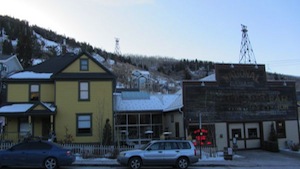 The restaurant and saloon are housed in a two-story Victorian house built in 1914 and the adjoining “National Garage,” once a livery stable for workhorses in the local mines. When automobiles became the latest rage, the stable was converted to a service station.
The restaurant and saloon are housed in a two-story Victorian house built in 1914 and the adjoining “National Garage,” once a livery stable for workhorses in the local mines. When automobiles became the latest rage, the stable was converted to a service station.
After a short wait, we were led through the walkway, past the still, and up a narrow flight of stairs into the adjacent house. Upstairs, we were seated in a cozy room overlooking historic Park City. Western vignettes of Roy Rogers and Annie Oakley adorned the walls while Johnny Cash music played in the background.
The drink menu boasts a number of tasty selections. From popular High West favorites (be sure to try the High West Lemonade) like Dead Man’s Boots and Whiskey Smash to the classic Manhattan or a shot or two of in-house distilled spirits, you’re sure to find something to whet your whistle.
The seasonal food menu is equally impressive -- and affordable. You can enjoy unique and lip-smacking “saloon bites” that promise only the freshest ingredients (and a dram or two of whiskey) in every dish and include bacon- and bourbon-flavored High West Popped Corn. Ask your waiter about the featured specials. We tried a juicy heirloom tomato stack (grown in Utah) and a zesty Wild Rice Mushroom Soup (yes, there was a delightful kick to it).
For the main dish, there’s something for everyone, whether you’re a meat lover or a vegetarian. Small plate offerings include Black Coffee & Bourbon Glazed Cod, while large and specialty plates feature Pan-Seared Utah Trout topped with Roasted Grape & Caper Berry Sauce, Idaho Elk with Chanterelle Mushrooms, and the infamous High West Burger. If you’re in the mood to share a meal, try the Whiskey Cheese Fondue.
You can even get kid-friendly Lil’ Buckaroo plates for the youngsters -- mac ’n’ cheese, spaghetti, and other kid faves. Summer desserts range from fresh fruit cobblers to a whiskey and chocolate sampler and more.
On your way out, don’t forget to stock up on your favorite spirits -- the General Store is the only state-registered store open for bottle sales on Sunday in Utah. In a state with strange alcohol laws (it’s dry on Sundays, folks!), it’s nice to know you can get a dram or two of whiskey when you want.
If you’d like to purchase this article for your publication, click here to contact the author directly.
By Diane Leone
Like stalking rare animals in the wild, I set out trekking through Hanna Park, hoping to capture a glimpse of an artist “Painting the Region.” Hanna Park in Mayport, Jacksonville, is a gorgeous area with a lake and beach access. After many stops, hikes, and beautiful distractions, I spotted a lone artist. She was in such a remote place -- with a spectacular ocean view -- that I tried a couple of hiking paths to reach her, to no avail. I settled for a distance shot and felt very inspired by the beauty I had seen and the images I had captured on my camera of lone surfers and stunning views. 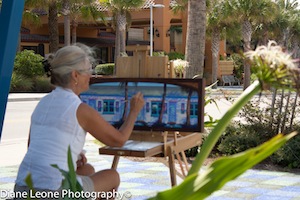 It was the first day of an event where artists would spend five days in different coastal regions of Northeast Florida creating a painting a day. The culmination of the event would be on Saturday, with all the art being shown and available for sale at a reception at the Ponte Vedra Cultural Center. All the proceeds go to the North Florida Land Trust.
It was the first day of an event where artists would spend five days in different coastal regions of Northeast Florida creating a painting a day. The culmination of the event would be on Saturday, with all the art being shown and available for sale at a reception at the Ponte Vedra Cultural Center. All the proceeds go to the North Florida Land Trust.
This third annual Painting the Region event in Northeast Florida featured coastal locations. Artists from around the region, as well as from other states and even as far away as Italy, could be spotted throughout the week, painting in generally-designated areas each day. The public was invited to watch the artists as they brilliantly captured the beauty of the area.
After I found the elusive artist in Hanna Park, I fared better in Old Mayport. On the other side of A1A, with marvelous views of shrimp boats and a quaint old fishing village juxtaposed with the Coast Guard and Mayport Naval Air Station, I found a group of artists painting shrimp boats and a pair of beautiful red vessels. Quietly they went about creating their art. What a great job! The weather was perfect on this first day of the paint-out.
Tuesday, I packed up my gear and drove to Old Atlantic Beach. Each day, the drive along the coast on A1A alone was amazing. Old Atlantic Beach epitomizes the quaint old Florida beach town. I found one artist standing at a busy five-way-stop intersection, deep in the heart of the Atlantic Beach community, painting a grand sculpture of a woman/mermaid riding a giant sea turtle. 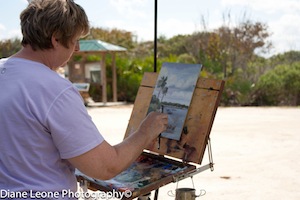 I was just about to give up on my MapQuest directions to the next artists’ location when I spotted an artist on a quiet road next to a park with children swinging and laughing. He was capturing a classic street scene of old homes and palm trees. I feel compelled to point out the obvious at this stage -- there were palm trees at each scenic location. I mean, it is, after all, coastal Florida.
I was just about to give up on my MapQuest directions to the next artists’ location when I spotted an artist on a quiet road next to a park with children swinging and laughing. He was capturing a classic street scene of old homes and palm trees. I feel compelled to point out the obvious at this stage -- there were palm trees at each scenic location. I mean, it is, after all, coastal Florida.
On Wednesday the artists were painting the Guana Preserve in St. Johns County, a stunning, protected area along the west side of A1A on the intercoastal waterway with the Atlantic Ocean just across the highway. I easily found a large group of artists at a spectacularly scenic spot along the preserve, with each artist staked out in a location to capture just the right view. Silent and windy, with blue skies, the marshy area was filled with brown reeds, greenery, blue water and birds. The occasional kayaker would come and go at the boat ramps, but otherwise, it belonged to the artists. They were getting a lot of support from passersby, with shout-outs and honking horns of support.
All the artists were willing to share their stories and their visions for the artwork they were creating. It’s quite calming and satisfying to watch artists do their magic and to observe how they interpret what they see and how the same view can look so different from artist to artist. 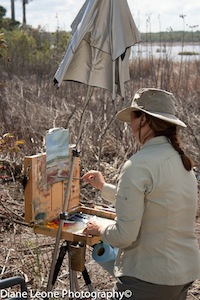 Thursday the artists were to be found either at Guana or Hanna Park painting ocean scenes, lake views, and intercoastal masterpieces. On Friday morning, the rain clouds were out, so my journey to Vilano Beach in St. Augustine started in the early afternoon as the sun and blue skies returned.
Thursday the artists were to be found either at Guana or Hanna Park painting ocean scenes, lake views, and intercoastal masterpieces. On Friday morning, the rain clouds were out, so my journey to Vilano Beach in St. Augustine started in the early afternoon as the sun and blue skies returned.
Vilano Beach Village (the entrance to Porpoise Point, a piece of land that juts out into the ocean and the intercoastal) is a beautiful place where two bodies of water meet and porpoise are often seen playing in the surf. An artist from Italy was set up on the pier, capturing the coastline of Porpoise Point and the rain clouds that had filled the sky. The artist, based in Rome, had been painting in Italy for seven years and was in Vilano Beach this day capturing a different but equally striking image -- old coastal Florida.
At the other end of the main drag between the pier and the ocean, I found an artist painting a run-down, closed hotel with pink flamingos on the shutters. A true beauty in its day -- and in the artist’s vision as it spilled onto her canvas. A man riding by on a bike stopped to ask her about it.
All in all, this is a truly unique event and a way to not only see with your own eyes some of the most dazzling coastal views in Northeast Florida, but also to spend lazy mornings and quiet afternoons watching artists capturing the same stunning views. You’ll watch in amazement as each canvas reveals a different interpretation of the same scene. 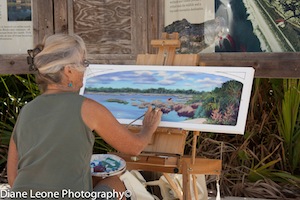 The North Florida Land Trust permanently preserves natural areas and special places in North Florida. This event will help fund the cost of creating the Conservation Resource Center, which will be established by purchasing and renovating the landmark Old Oar House Restaurant property on Mickler Road in Ponte Vedra Beach. For more information on the North Florida Land Trust go to www.NorthFloridaLandTrust.org and for more information on this unique event go to www.PaintingTheRegion.com.
The North Florida Land Trust permanently preserves natural areas and special places in North Florida. This event will help fund the cost of creating the Conservation Resource Center, which will be established by purchasing and renovating the landmark Old Oar House Restaurant property on Mickler Road in Ponte Vedra Beach. For more information on the North Florida Land Trust go to www.NorthFloridaLandTrust.org and for more information on this unique event go to www.PaintingTheRegion.com.
The event is free for visitors and locals alike and is a wonderful way to explore some tucked-away views and to see them through the artists’ eyes.
If you’d like to purchase this article for your publication, click here to contact the author directly.
By Holly Brega Stumbling around in the dark without waking any of the 10 sleeping travellers was a little harder than I expected.
I was impressed with myself for packing my rucksack the night before, as it would now be close to impossible. Stepping over bags, guitars, and beer bottles without disturbing a soul was the first mission of the day. What I was about to do would be remembered forever.
Travel north from the city of Christchurch in New Zealand and you will find the town of Kaikoura. It is renowned for whale watching and home to an abundance of albatross and many species of fauna and flora. Having found my bike, I cycled along the waterfront, witnessing the sun rising to meet a small body of people in the distance. They’d had to face the same obstacles as I did earlier that morning. As we suited up, the chatter was limited but the warm glow from the sun seen in each other’s eyes seemed to say more than words.
After choosing snorkels we headed out to the water’s edge. I could sense the excitement heightening and the restlessness starting to show. Rosy cheeks flourished and bright eyes stared out to the clear, still waters off the peninsula of this small coastal town. It looked calm now, but I knew that would soon change. As the boat rode the waves over the Hikurangi Trench, my eyes fixed on the sunrise. Closing my eyes for two seconds, I would then open them to find a new array of colors through my camera lens.
These waters are full of marine life that provides rich feeding grounds for many species of dolphin and whale, and very soon a pod of around 200 dusky dolphins accompany us.
These inquisitive marine mammals were playing all around the boat and before I knew it, I was swimming alongside them. All the commotion bubbles reduce my long distance vision, and as I look up out of the water a small pod are swimming straight for me. I emit a high pitched squeak, a noise I’m told will tell them you are not a threat, and wait. Suddenly, about a foot and a half in front of my nose, I find a dolphin nose.
That split second I will always hold in my memory. I can see into his eyes, I can tell he means me no harm, I feel so close to him. Then, in the blink of an eye, he swerves smoothly, yet sharply, to my right. The distance and timing were perfect. Any more and he would have knocked straight into me. Any less and he would not have satisfied his own curiosity.
Back on the boat hours later, as we return, the sun is high and the mountain range is waking up. I feel rejuvenated. Returning silently to my dorm, I find not a kiwi has stirred.
If you’d like to purchase this article for your publication, click here to contact the author directly.